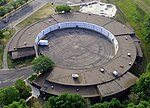Ames Center

The Ames Center, formerly the Burnsville Performing Arts Center, is a performing arts venue in Burnsville, Minnesota, adjacent to Nicollet Commons Park, which features green space, water fountains, and a 250-seat outdoor performance amphitheater. The Ames Center features an eclectic range of performances on the main stage and the black box theatres including: dance, theatre, concerts, comedians, and written word. Past performances include the Girl Singers of the Hit Parade, Larry Carlton, Louie Anderson, Lori Lane, Richard Marx, Church Basement Ladies, Melissa Manchester, Bill Engvall, Nick Colionne, Celtic Crossroads, Twin Cities Ballet of Minnesota, Elizabeth Gilbert, Rob Lake, Tommy Emmanuel, Sinbad, Ralphie May, Dakota Valley Symphony, Chameleon Theater Circle, Miss Minnesota USA/Teen USA, and Cirque D’Or. Additionally, productions of Mame, A Christmas Carol and Peter Pan were presented utilizing sets created for the Kennedy Center, the Kodak Theatre and the original Cathy Rigby Broadway production respectively.
Excerpt from the Wikipedia article Ames Center (License: CC BY-SA 3.0, Authors, Images).Ames Center
Nicollet Avenue South,
Geographical coordinates (GPS) Address Phone number Website External links Nearby Places Show on map
Geographical coordinates (GPS)
| Latitude | Longitude |
|---|---|
| N 44.7741 ° | E -93.2795 ° |
Address
Ames Center
Nicollet Avenue South 12600
55337
Minnesota, United States
Open on Google Maps








